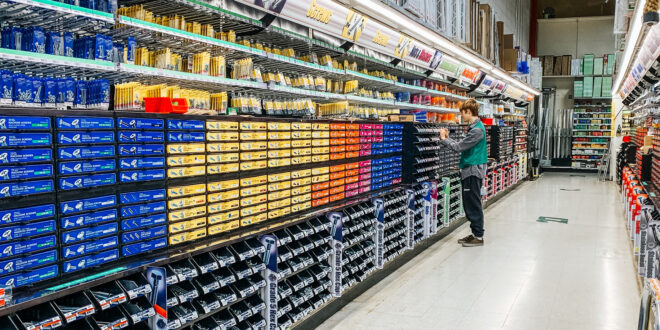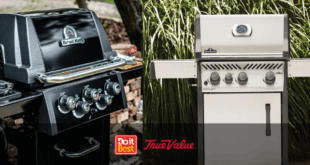Tackling a category reset can be a daunting challenge, but is often necessary to keep your store fresh and customers satisfied. With the right partner and planning, however, a reset can transform the product offering and the customers’ experience. Learn from one retailer who revamped his fasteners category—a project requiring extensive preparation, collaboration and adaptation.
Identifying the Problem
Change was needed at McGuckin Hardware in Boulder, Colorado. Plumbing, hardware, and fasteners manager Michael Gillette says the store had struggled with its previous supplier, facing issues such as order fulfillment delays and challenges with his sales representatives. This led to his search for a new fasteners supplier.
“Our previous supplier was not meeting our expectations, and it was frustrating,” Gillette says. “When we found a new supplier, we met with them and discussed the logistics, looked at timelines and figured out how to reset this category.”
Gillette says his team took their current fasteners area and sketched different layout options and sent those proposals to their new supplier, who then made adjustments based on their planograms, but also gave them what Gillette’s team asked for in the best way possible.
“Once the planning phase was done, we were left with nailing down a time to begin,” he says.
Gillette says any store looking to reset a category like fasteners should do so during their slowest periods, which for McGuckin’s, was January through March. This allowed the team to maintain the old fastener aisle’s functionality while transitioning to the new setup.
Before
Once the time came to begin the fastener category reset, Gillette says his new supplier brought in a team of employees to help dismantle the old setup and take away old stock before bringing in the new assets.
McGuckin Hardware was with its previous supplier for many years, so Gillette’s team fine-tuned the category, making it the best for them and their customers. Admittedly, Gillette says making this big of a change was daunting, but throughout the process, he knew he made the right choice.
“Now, we have a greater variety of products, and for our customer base, that is a necessity,” he says. The new fastener aisle is more than just a visual improvement. The selection has grown significantly to meet the unique demands of the store’s diverse customer base, which includes tech developers, high-end electronics specialists and even national laboratories.
“I’ve had a customer come in and ask for a very specific stainless steel component; you never know where that product is going to end up,” Gillette says. “We’re proud we’ve set a high standard for performance, customer satisfaction and meeting our customer’s expectations. Resetting our fasteners category has helped us meet those high standards.”
During
Whenever a store is changing an integral part of its product offerings, keeping the project on time is important. Gillette says he expected challenges, which fortunately ended up not being as severe as he thought.
For example, during the fastener category reset, shelving for the aisles was delayed in transit, but the team working on the reset didn’t let that stop them from working and found a solution—finding new vendors for the same product and having
them expedited.
McGuckin’s new fasteners vendor was able to prefabricate the new aisles before bringing them into the store, allowing the operation of the previous aisles during the reset.
“The people who assisted us in this category reset weren’t just hired for this project,” Gillette says. “They were people we’d be working with long after the project was finished. That level of commitment spoke volumes. We had some problems, but when you have the regional sales director calling people and fixing problems, it makes everything easier.”
“The people who assisted us in this category reset weren’t just hired for this project. They were people we’d be working with long after the project was finished. That level of communication spoke volumes.” —Michael Gillette, McGuckin Hardware
After
Once the reset was completed, which took Gillette’s team and their new supplier three months, products were added and removed to adapt to McGuckin’s customer base.
“Our new supplier didn’t anticipate some of the products we were stocking,” Gillette says. “When they looked at a typical hardware store in our zip code, they were surprised at what we were selling and helped us adapt our purchasing to fit.”
Since the reset, Gillette says customers have responded positively to the brighter, more spacious aisles and expanded product selection. The new aisle layout and added space allow Gillette’s team to add touchpoints in the fasteners category and be there to help them.
“Are we satisfied? Not yet,” Gillette says. “We’re continuously refining our inventory and layout to meet our customer needs. But we’ve made great strides and the feedback we’ve received has been positive.”
Category Reset Tips
While the reset of the fasteners category at McGuckin’s was a success, the process didn’t come without challenges. From shelving delays to customer retraining, the team encountered hurdles that required flexibility and quick problem-solving. McGuckin Hardware’s fasteners manager Michael Gillette offers his best practices for category reset success.
Focus on One Project at a Time
During the problem identification stage of a category reset, you may find other categories that could also benefit from
a reset. It’s important to focus on one project at a time and not attempt to tackle multiple resets simultaneously.
“At one point, we had three category resets happening concurrently and that caused some challenges with so many moving parts, people and personalities,” Gillette says. “If you’re going to do a reset, start one and finish it before the next.”
Choose the Right Partner
Having a supportive vendor is crucial. If you’re not confident in your vendor’s ability to assist you, it’s worth looking for other
partners who will.
“Finding the right partner is essential,” Gillette says. “I can’t emphasize how important it is to have a strong relationship with your vendor.”
Plan for the Long Term
A reset isn’t complete once the new layout is in place. After the category reset is finished, it takes months to fine-tune inventory and placement to maximize margins and processes.
Train Employees and Customers
Retraining your employees and customers is essential. Employees need to understand the new layout and where products are to best help questioning customers.
“If you’re doing a category reset, you’re going to have customers come up to you and say, ‘You used to have this product 20 years ago and you don’t have it anymore.’ when in reality, it’s just in a different spot,” Gillette says. “Pay attention to your
customers’ feedback.”
 Hardware Retailing The Industry's Source for Insights and Information
Hardware Retailing The Industry's Source for Insights and Information








